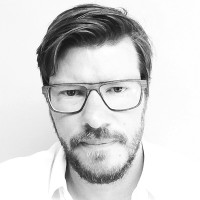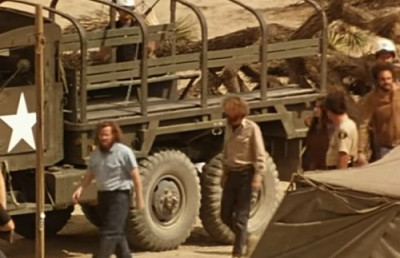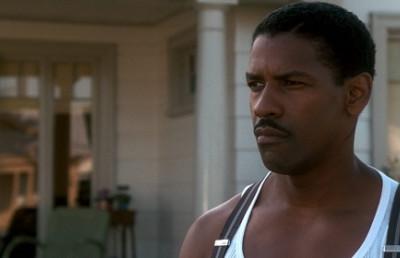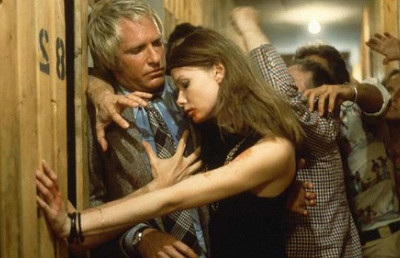Zones: Post-industrial aesthetics and environments after Stalker
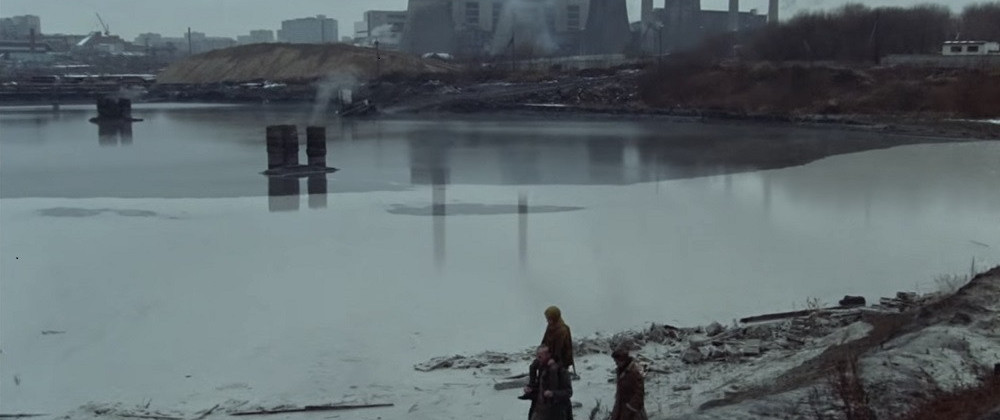
A version of this essay was first published in 2019 at Strelka Mag, the digital publication of Strelka Institute for Media, Architecture, and Design. Strelka was a leading Eurasian center for progressive thought during its period of operations (2009 — 2022). In March of 2022 the Institute took a position against Russia’s invasion of Ukraine. They posted anti-war slogans in English and Cyrillic on social media, and a few days later suspended all operations. Strelka’s websites have since been taken down. The future of the Institute is uncertain. This essay, “Post-Stalker,” was one of the most widely-cited and viewed articles published at Strelka Mag. The author would like to thank the editors at Offscreen for making it available to internet audiences again.
+++
Andrei Tarkovsky’s Stalker (1979) is as enigmatic as it is visually arresting. The film retains an ability to mystify contemporary audiences. Its philosophical meditations and spiritual themes are as relevant as ever. Stalker’s imagery continues to inspire artists, writers, and filmmakers. The relationship between Stalker’s human protagonists and their post-industrial settings, and the representation of these settings through a refined environmental aesthetic, are essential to the film’s identity. The film radically advanced artistic representations of industrial and post-industrial landscapes, complicating existing aesthetic tropes while updating them for new generations of artists. In many ways we are still learning to be Tarkovsky’s contemporaries.
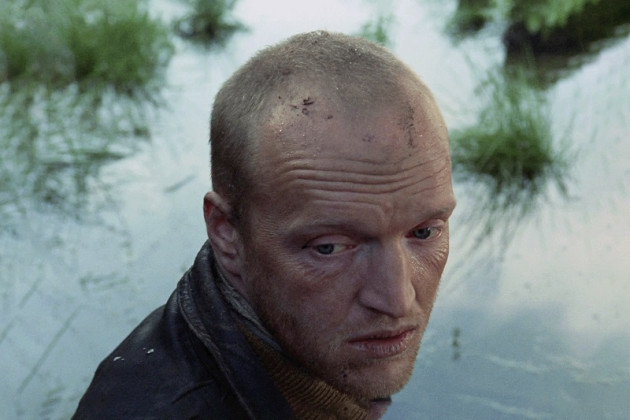
Alexander Kaidanovsky as the guide, the Stalker
With Stalker, Tarkovsky also originated a post-Soviet, post-industrial genre that documents sites of decay and abandonment, today widely consumed on social media and glossy photo books. Stalker’s characters transit through poetically-charged landscapes of industrial ruin and resurgent nature. Tarkovsky’s camera lingers on abandoned artifacts, industrial riverfronts, contaminated landscapes, and patches of ruderal vegetation. This imagery simultaneously inaugurated and transcended a so-called “ruin porn” aesthetic which similarly features abandoned industrial sites and architectural decay. Stalker’s oneiric representations of post-industrial landscapes, however, are arguably far more complex and nuanced than the imitators which followed. Tarkovsky speaks to emotions and concepts which rise above an easy aesthetics of ruin.
Tarkovsky’s 1979 film serves as inspiration and entry point for discussions of post-industrial environments. Yet Stalker is more than just a muse. We can also recognize the film as a degree-zero work which established a new visual language to represent landscapes and built environments. Tarkovsky crosshatches the film’s physical settings with human attempts to understand post-urban and post-industrial environments which seem to be slipping beyond our control.
_photo_by_Sergei_Bessmertniy_630_408_90.jpg)
Photo from Estonian set of The Stalker. Photograph by Sergei Bessmertniy
The screenplay was adapted from a novel, Roadside Picnic, by Arkady and Boris Strugatsky. The novel was stripped of much of its narrative and reduced to a part of the story in which a “Stalker,” a professional guide, brings two men (the Professor and the Writer, themselves amalgamations of different characters in the novel) into a forbidden region known as the Zone. Cordoned off from society, its entrances heavily guarded, the Zone and its alien interiors are a mystery. Whereas Tarkovsky’s Solaris (1972) exhibited the trappings of the sci-fi genre, here the director removed overt genre elements in favor of thematic purity and visual ambiguity.
Shot principally in the Estonian Soviet Socialist Republic, Stalker’s locations are as vital to the film as its human characters. Landscapes and buildings exhibit a screen presence equivalent to that of the actors. In the novel, the Zone is a forlorn place visited by advanced extraterrestrial life and littered with fantastic objects. One of these objects, a box discarded by the aliens, can supposedly fulfill wishes. The novel’s title refers to the haphazard nature of this intergalactic visitation. In Tarkovsky’s adaptation the backstory is suppressed. The Zone and its strange artifacts become ineffable, lacking narrative context, and thus able to project and absorb multiple interpretations.
Tarkovsky’s cinematic vision of the Zone is a postmodern creation. The Zone contains the detritus of modernity, perhaps reflecting the failures of industrial society. At first glance the Zone may appear to follow in the Romantic landscape tradition. Yet it differs notably in its relationship to human experience: the flaneur in the Romantic garden is lost in reverie, whereas the Stalker and his company have neither time nor desire to savor notions of the picturesque and sublime. Their path through the Zone is purposeful, arduous, sometimes dangerous. Critics have proposed reading the Zone allegorically, perhaps representing the gulag or the militarized borderlands between the Soviet bloc and the west. But such readings are ultimately too restrictive. Tarkovksy himself, in interviews and published writings, famously resisted overtly symbolic or single-metaphor interpretations.
By the late 1970s there was plentiful evidence of devolution and decay in the physical infrastructures of the Soviet Union. Tarkovsky had originally intended to film on location near Isfara, in Soviet Tajikistan, an ancient town situated at the edge of a high desert in remote Central Asia. But an earthquake which wrought havoc on the region during Stalker’s pre-production made filming there impossible. Costume designer Nelli Fomina, who worked with Tarkovsky on several films including Stalker, had seen location shots from Tajikistan which she described as “ghastly and forbidding—it would have been our undoing” (2015: 160). This footage has been lost, but we can imagine how Tarkovsky would have been attracted to a menacing, desert-like landscape at the hinterlands of Soviet civilization.
_photo_by_Sergei_Bessmertniy_630_411_90.jpg)
Photo from Estonian set of The Stalker. Photograph by Sergei Bessmertniy
After researching numerous potential locations across the Soviet Union his production team identified a suitable alternative: an industrial district outside of Tallinn, along the river Jägala. Here Tarkovsky found the ruins of a power station destroyed during the second world war. Nearby was an abandoned oil refinery and a working paper mill that belched waste into the river. Tarkovsky and his crew also filmed several climactic scenes inside an active power station in central Tallinn.
The landscapes around the Jägala were treated as-found, with the minor addition of disused military equipment and railroad tracks for dolly shots which created the celebrated sequence where the Stalker and his companions travel by motorized trolley deeper into the Zone. The post-industrial landscape with its detritus and ruins, not least the abandoned power plant, provided much of Stalker’s visual texture and unsettling atmosphere.
Zones of Ruin and RegenerationIn the so-called ruin porn genre of photography, visual textures are all surface effect at service of the fetishization of abandonment. Many of these genre photographs are often quite accomplished. The detailed vastness of Edward Burtynsky’s industrial landscapes, for instance, may be considered a technical peak. However, the real achievement, and part of the attraction of ruin porn, occurs off-camera in the act of the photographer travelling to remote and forbidding places, negotiating with the authorities or otherwise dodging them, setting up expensive camera equipment on location, and finally capturing the prized, publishable image. Stereotypical examples might be an abandoned nuclear power reactor, a crumbling Black Sea port, a turbine hall with its roof cracked open to the sky, or a satellite dish overgrown with climbing plants.
Part of the romance of these images is in getting there to capture them. The armchair explorer thus gains access to exotic locales across the former Eastern bloc and elsewhere in the post-industrial world: she stalks the haunted nature reserve of Pripyat, wanders the dusty steppes or snowy tundra on her quest for abandoned rocket launches, tucks into dry-docked submarines, or lowers herself into disused quarries. We thus join the photographer driving or drifting through the suburbs of Moscow, Tashkent, or Yerevan, gazing in melancholic wonder at the abandoned factories and hotels. We take a guided tour of expressionistic monuments of former Yugoslavia or the whimsical concrete bus shelters of the ‘stans.
_630_420_90.jpg)
Pripyat photo by Jorge Franganillo (Wikimedia Commons)
Yet if we leave the armchair to actually visit some of these sites, we realize that “dead space” isn’t really. Spaces are places. And post-industrial places are always in flux, either regenerative through natural succession, or transformative through socio-economic or technical endeavor. Photographs in the ruin porn genre capture a moment in time. They typically aestheticize the ruin as a late-modern picturesque, today with Instagrammable immediacy. They represent a new spin on the cult of the Romantic ruin, a cult which has enjoyed cycles of fashion in the west since antiquity.
Perhaps a more honest photographic representation of the industrial ruin would be a visual timeline. This would require archival research as well as return visits to document a site over months and years. But who has time for that? While many of us derive pleasure in looking at images of latter-day ruins, much of that pleasure is merely voyeuristic. It lacks social, political, historical, and geographic contexts for any given image. The viewer wouldn’t know it from looking at the photos but there are often thriving, even bustling, urban communities or agrarian activities just beyond the edge of the frame. 1
An important distinction between Stalker and the genre images is the obvious structural quality of cinema as a time-based art versus the static purity of photography. In cinema there is (usually) the (simulation of the) moving image, plus sound. Tarkovsky, for all his reputation of being a father of “slow cinema,” invests his images with carefully choreographed movement and animated mise-en-scène, sometimes subtle but also vivid and dynamic.
Tarkovsky’s landscapes are always alive with natural forces. Sun and rain, wind and fire, and tangles of vegetation animate his long takes and complex tracking shots. His camera’s fixation on limpid currents of water is a notable example. Nature becomes a tangible and vital force in Tarkovsky’s cinematographic language. The camera may brood, yet it does so with movement and life.
“Often we remove nature from films because it seems useless,” Tarkovsky said in an interview. “We exclude it thinking we are the real protagonists. But we are not the protagonists because we are dependent on nature. We are the result of its evolution. I think to neglect nature, from an emotional and artistic point of view, is a crime” (Gianvito 2006: 48).
Another important distinction between Stalker and ruin porn is the absence of people, and of human agency generally, in the genre images. Ruin porn offers only objectified dereliction. The absence of people amplifies the appeal of the picturesque ruin. In Tarkovsky’s cinema, however, people and their environments become entangled, multifaceted representations of “nature.” The environment also gives shape to narratives while altering the protagonists’ realities. Tarkovsky is the odd humanist who does not always appear to place humans at the center of things. His filmic environments often upstage his actors. In Solaris, memories are physically manifest as visitors on the haunted space station. Rooms and domestic objects shift and shimmer with an inner life in Mirror.
The genre photos at their best exude a compelling “world without us” pathos. But their reductive viewpoint lacks the nuanced critiques of, say, recent post-humanist thought or media archeology. Nor do they necessarily engage the complexities of actual societal responses to abandonment and failure. Stalker provokes us, showing us how thin the veil is between society and collapse, between civilization and apocalypse. In times of uncertainty—climate crisis, geopolitical instability and conflict, pandemic—such scenarios are all the more disturbing. Tarkovsky was a prophet of the “slow apocalypse”: the gradual, invisible, yet insistent and inevitable collapse of modern industrial societies. An undercurrent of eschatological anxiety also exists in the Russian Orthodox church, and Tarkovsky, as a lapsed Orthodox Christian, would have been aware of these in his time.
Embodied LabyrinthsStalker, unlike many of the genre photographs that it inspired, enlivens its post-industrial settings with the presence of actors, dialogue, and purposeful movement through the landscape. Tarkovsky’s mise-en-scène is dependent upon his protagonists to give meaning to the Zone, an otherwise inscrutable place. The Stalker and his companions bear witness to this strange environment to better understand their own desires.
Within a landscape that is by turns banal and lethal, the Stalker appears to possess limited agency. The Zone is literally a minefield, a labyrinth, a trap. The Stalker guides his companions through a cryptic neo-wilderness with its own rules and rites of passage. Their passage is physical, an embodied experience that relies on all the human senses, not just the visual. Tarkovsky’s camera lingers upon the trio as they glide across a railroad track, wade through industrial canals, and trudge through tunnels. An earthiness and pervasive dampness are conveyed throughout, helping the viewer, if not to empathize with the characters, then to experience their journey more viscerally.
The film’s soundscape brings together field recordings of the natural environment as well as studio sound effects and compositions. Use of non-diegetic sound is minimal. Composer Eduard Artemiev, who also scored Solaris and Mirror, chose to blend synthesizer music with natural sounds to reinforce the journey into the Zone and its contradictory qualities of physicality and otherworldliness.
Stalker, like all Tarkovsky’s films, deals with themes of human consciousness, memory, spirituality, and the struggles of keeping faith despite a secular society in a rapidly modernizing world. His imagery shifts in emphasis and scope from sweeping exterior vistas to intimate studies of the human figure. It has been noted that Tarkovsky filmed the human head in ways that it had never been filmed before, rendering it “monumental, sculptural and philosophical,” in the words of film critic Mark Le Fanu (2015: para 5). The rugged head of the Stalker, for instance, becomes its own cinematic texture. The actor Alexander Kaidanovsky’s face is a landscape of scars and scabs, worry lines, and dirt. His hair is brutally shaved, as if he were a prisoner or soldier. The wardrobes, too, as they become increasingly soiled over the duration of the film, reflect the characters’ passage through the Zone.
Filmmakers often deploy architecture and landscapes to reflect a character’s emotional state or inner conflicts. This is famously illustrated in the 1960s films of Michelangelo Antonioni. His alienated protagonists inhabit isolated, austere, and frequently industrial and peri-urban settings. Cinematic language has uniquely developed a synthesis between subject and object, between protagonist and place, in ways which have more in common with architecture or music than with other artistic modes such as painting, theater, and literature.
Post-Stalker EnvironmentsPrior to Tarkovsky’s film the post-industrial aesthetic probably bore its greatest fruit in the work of artist Robert Smithson during the 1960s–70s, in particular his non-sites, photographic documentation of industrial landscapes, and essays such as “The Monuments of Passaic” (1967). For Smithson, the sublime reemerges with the urban infrastructures and industrial landscapes of the modern era. His works reference geological time and seem to evacuate socio-cultural concerns in favor of an obsession with material qualities inspired by minimal art, entropy, and cyclical processes.
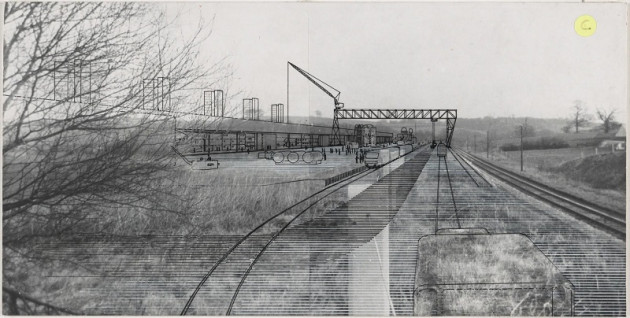
Visualization of Potteries Thinkbelt Project 1964-66, Cedric Price
Beyond art, in the disciplines of architecture and environmental design, there were few precedents until the 1980s of rigorously-imagined designs for the post-industrial landscape. Notable exceptions include the Potteries Thinkbelt project for North Staffordshire by English architect Cedric Price. This speculative work imagined kilometers of abandoned railroad infrastructure transformed into an experimental high-tech campus whose rail-based facilities would be mobile, networked, and flexible. Price designed modest interventions to create classrooms and laboratories. The remaining industrial ruins would be conserved until a future time when they could be recycled or repurposed.
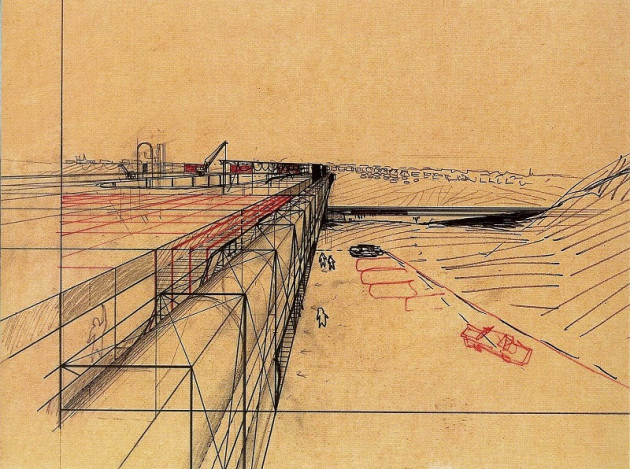
Perspective view of Potteries Thinkbelt Project 1964-66, Cedric Price
Seattle Gas Works Park when it opened in 1975 was among the first public spaces in North America to preserve industrial artifacts for aesthetics and adaptive reuse. The designer, landscape architect Richard Haag, fought a long public battle to retain parts of the decommissioned gas plant on the site. Many residents did not understand Haag’s embrace of industrial heritage and opposed the post-industrial appearance of the park. Today, the park on the lake front is a beloved destination for locals and visitors.
Perhaps the most popular example of post-industrial architecture is New York City’s High Line, designed by James Corner Field Operations with Diller Scofidio + Renfro. Plant design by Piet Oudolf draws inspiration from plant communities on disturbed sites. The High Line re-created and aestheticized the as-found conditions of the abandoned elevated railway, including fragments of the abandoned railroad tracks. Spontaneous plant growth which existed on the site prior to its renovation featured in early promotional photographs. These images practically glowed with nostalgia for a pre-gentrified Manhattan.
The High Line demonstrates how preserving and reusing what is already existing, rather than demolishing and building anew according to the vicissitudes of the real estate market, is often the most sustainable architecture. When the contemporary manifestation of the High Line becomes outdated or no longer feasible to maintain, its legacy will be the preservation of an extraordinary post-industrial artifact for continued enjoyment by future generations of New Yorkers.
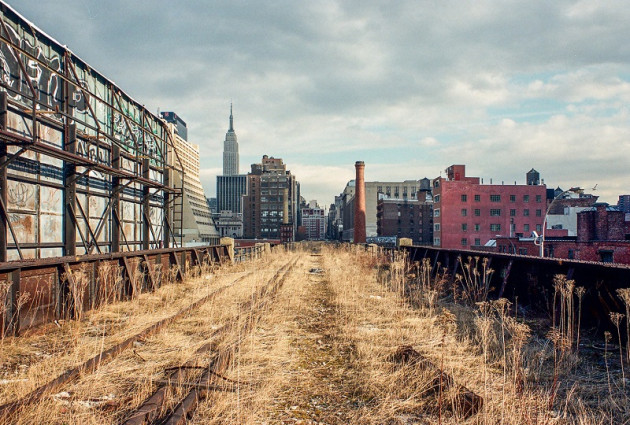
High Line looking east-2001 photo by Andrew van Leeuwen
French horticulturalist and landscape architect Gilles Clément uses the term “third landscapes” to describe left-over spaces outside of cultivation, program, and function. Like Oudolf, Clément has been at the forefront of landscape design practices that privilege the unmediated dynamics of nature and a preference for wild aesthetics driven by ecological imperatives. The third landscape, according to Clément, is “an undecided fragment of the planetary garden […] made up of all the places neglected by human beings. These margins bring together a biological diversity that has not yet been classified as richness.” It is the genetic reservoir of the planet, a resilient landscape for the future. 2
Clément describes a singular example in Lille, France, realized in 1995 to his designs. Parc Henri Matisse, where a central plateau built of concrete and soil, rising seven meters above the surrounding park and inaccessible to human foot traffic, has been planted with a model forest. The plateau is an urban refuge for biodiversity. A visual landmark, it is monitored for ecological health and serves as an index for sustainable management of eight hectares of public park.
Stalker anticipated this recent emphasis on regenerative landscapes and popular acceptance of unmanicured nature in cities. Today we might detect traces of optimism in this wild aesthetic: a dirty realism of ecological resilience and succession. Prompted by Tarkovsky’s humanist themes and our entanglements with the post-industrial world, we might go even further to locate a new kind of post–_Stalker_ metaphysics in the regenerative landscapes of urban failure and industrial ruin.
From Post-Stalker to Post-human“Central to Tarkovsky’s formal principles” writes John Gianvito in his introduction to an English translation of interviews with the filmmaker, “is the conviction that cinema’s most distinguishing characteristic, in comparison to all other art forms, is its literal ability to capture and preserve the flow of time” (2006: xii).
Tarkovsky’s cinema addresses built and natural environments as temporal subjects and not merely as scenery. Architecture, objects, and landscapes are elemental yet fragile components of his cinema. The post–_Stalker_ sensibility embraced by this essay prioritizes duration, flux, and decentering of the human subject. As an aesthetic it cannot readily be reduced to a type or monolithic representation.
With his long takes and restrained editing, Tarkovsky invites his audience to experience the passage of time, to sit with characters and settings in the lived reality of their cinematic worlds. Thoughtful viewers may reflect on duration and human perception, or the distinctions between human time, natural time, geological time, and cosmic time. Tarkovsky’s cinematic language resonates with the temporal qualities of post-industrial environments. Such environments are defined by mutability, each place having its own site-specific, spatio-temporal conditions, with strong or weak ties to society, and ever-shifting relationships with human protagonists.
The immersive world of Stalker opened new ways for representing and thinking about our relationships with the built environment, including our fears and anxieties around abandonment, failure, and the unknown. With the Zone, Tarkovsky (perhaps unintentionally) developed an aesthetics of the post-industrial. It is an aesthetic which still feels contemporary.
Post–_Stalker_ environments lie in two possible continua: natural ecological succession with limited or no human agency, and transformation to new uses with humans at the center. Ruin porn captures a moment along either continuum. It might celebrate picturesque abandonment or capture nostalgia for lost futures, what critics like Mark Fischer have called hauntology. Stalker captures moments along the former continuum. It challenges us to imagine futures in which the human condition is increasingly circumscribed.
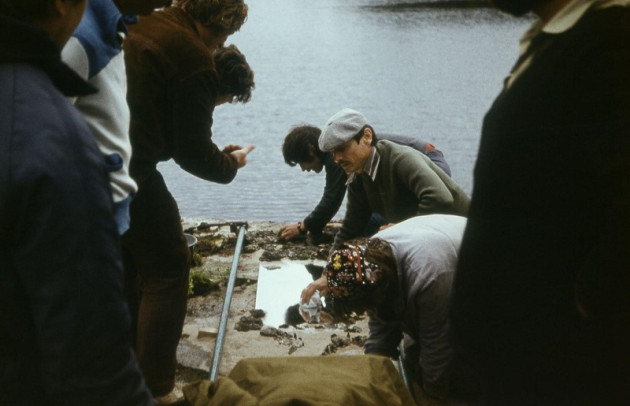
Photo from Estonian set of The Stalker. Photograph by Sergei Bessmertniy
At one end of a continuum where nature succeeds the machine lies the romantic possibility of “the world without us.” Post-humanist philosophy tries to understand perspectives of non-human species, even of objects, of things hitherto regarded as non-entities, alien, or “other.” As articulated by philosophers and ecological theorists such as Donna Haraway, Timothy Morton, or Jakob Von Uexhall, post-humanist thought provides insights into post-urban and post-industrial scenarios where people have more or less left the scene.
So far, humanity has failed to confront the horrific scope of environmental catastrophe wrought by industry, along with our failures, or unwillingness, to mitigate the negative externalities of capitalism. We will probably never be able to fully clean up our messes and restore putative nature. Yet we need to collectively acknowledge our failures and begin to atone for them. Wherever possible, we should strive to restore ecosystems and deliver environmental justice (for human and non-human species alike). Post-industrial sites and monumental works of art like Stalker serve to remind us of our need for atonement, even as we pass the tipping points of irreversible climate change.
Towards a Spiritual ApocalypseTarkovsky’s cinema is overtly concerned with spirituality and the struggles many of us experience when reconciling the sacred and profane, the transcendent and the immanent. His film’s achieve what Francis Bacon once said is the primary responsibility of the artist: “to deepen the mystery.” Stalker conveys spiritual themes through dialogue, and visually through the film’s post-industrial settings where people strive and fail to rise above their stations. An elliptical, minimalist narrative demands that audiences arrive at our own conclusions.
Stalker’s central characters—the Stalker, the Writer, and the Professor—make a sort of pilgrimage through a hostile yet hauntingly beautiful environment to locate the Room, a sacred place that purportedly grants wishes or bestows enlightenment upon the seeker. The Zone is devoid of human life apart from the Stalker and his fellow trespassers. Others who sought the Room have not returned home. Perhaps all of (spaceship) earth is one vast planetary Zone where industrialized society is the trespasser. Perhaps the salvation we seek exists only in our imaginations.
Where, Tarkovsky asks, can we find spiritual meaning in the post-industrial world, suffocated by so much meagerness, failure, apathy, and pollution (physical and psychic)? Will a “world without us” retain its sacred places? On the other hand, could there be anything sacred remaining in those posh, post-industrial sites of adaptive reuse and architectural “upcycling,” those fashionable urban districts and enclaves which have recently emerged—across central Moscow, in Mumbai, New York, Mexico City, Beijing, Tokyo, and other global metropolises—where factories have been converted to co-working spaces, boutique shops, ateliers, residential lofts, and artistic happenings? Such environments may indeed nourish the collective spirit of the city and its inhabitants. But successional economic processes of gentrification will ultimately neutralize any social benefits.
In Stalker the landscape appears sentient. It might be a minefield but it is also a place where powerful, mysterious natural and perhaps supernatural forces thrive. If Tarkovsky were making Stalker today, what would he have to say about the sixth mass extinction coinciding with the fourth industrial revolution, as global warming continues apace? Would his already tragic view of the human condition be further diminished, might his characters be rendered with more fragility and sympathy? For Tarkovsky’s audiences, we are left with more questions than answers. Stalker continues to present an open-ended and challenging vision of our role in the post-industrial world we’ve created.
+++
CodaAndre Tarkovsky died of bronchial cancer in 1986 at the age of fifty-four. Tragically, Tarkovsky’s wife Larisa and the actor Anatoly Solonitsyn died of the same type of cancer, while several others reported being ill or having severe allergic reactions during filming. The crew had been exposed for weeks and months—during an initial shoot and later reshoot with a different cinematographer—to a place that was literally poisonous. It would take decades for the landscape to heal. Yet, as documented in Tarkovsky’s film, the regenerative processes of nature and its adaptive, ruderal ecologies were already underway at the time of production. The seeds of post-industrial succession, with and without people, were already present in Stalker.
Bibliography
Clément, Gilles (2022), Manifesto of the Third Landscape, TEH Series on new imaginaries #3 (Trans Europe Halles).
Fomina, Nelli (2015), Costumes for the Films of Andrei Tarkovsky (Cygnet).
Gianvito, John, editor (2006), Andrei Tarkovsky Interviews (University Press of Mississippi).
Le Fanu, Mark (2017), “Stalker: Meaning and Making,” The Criterion Collection, https://www.criterion.com/current/posts/4739-Stalker-meaning-and-making
Notes
- A related genre of architectural photography specializing in Brutalist and socialist buildings from the 1950s-80s can be understood variously as empty aestheticization or as commentary on the socio-political aspirations and optimistic ideologies which often sponsored socialist building programs. ↩
- Clément continues: “If we stop looking at the landscape as the object of an industry, we suddenly discover – is it an oversight on the part of the cartographer, an act of neglect on the part of politics? – a quantity of undecided spaces, devoid of function, that are difficult to name. This ensemble belongs neither to the territory of the shadow nor to that of the light. It is located on the margins – on the edge of the woods, along the roads and rivers, in the forgotten corners of cultivation where machines do not pass. It covers areas of modest dimensions, scattered like the lost angles of a field; unitary and vast like peat bogs, moors and certain wastelands resulting from recent abandonment.” (2022: 5-6) ↩

